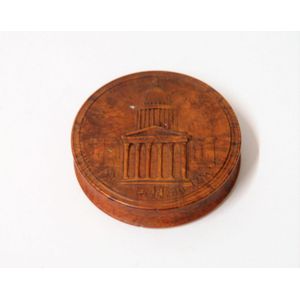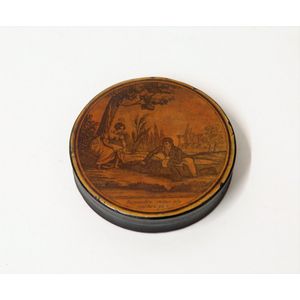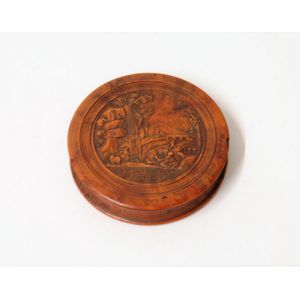Exotic Birds-Eye Maple Snuff Box with Tortoiseshell Lining
You must be a subscriber, and be logged in to view price and dealer details.
Subscribe Now to view actual auction price for this item
When you subscribe, you have the option of setting the currency in which to display prices to $Au, $US, $NZ or Stg.
- Maple - Maple, native to North America, is a dense heavy timber from light to yellow-brown in colour. It has very little distincive graining unless it is one of the variants such as birds-eye maple or burr maple, so was not used extensively for furniture in 18th and 19th century, where cabinetmakers and designers preferred timbers with more distinctive features such as mahogany, walnut, rosewood and oak.
Birds-eye maple has a seres of small spots linked by undulating lines in the grain, is highly sough and is used as a decorative veneer. Burr maple has larger and irregular grain swirls than birds-eye maple. - Tortoiseshell - Tortoiseshell is a translucent material that comes from the horny carapace of a certain types of turtles, including the hawksbill turtle. It is often therefore mounted on a colour underground - often red - or inlaid with gold or silver thread, as seen in Boulle furniture.
The texture and colour nuances of the material are extremely important. Heated tortoiseshell can easily be formed into various shapes. Like other natural materials, tortoiseshell becomes more beautiful with use. In a time before plastic, tortoiseshell was widely used for small objects such as combs and powder compacts.
In 1973, the trade of tortoiseshell worldwide was banned under CITES (The Convention on International Trade in Endangered Species). Prior to importing or exporting items containing tortoiseshell a CITES permit must be obtained. Tortoiseshell items cannot be traded on Ebay.
"Faux tortoiseshell", another case of man initiating nature, is made from old-style plastics such as celluloid and cellulos and is coloured with red, yellow and brown spots to imitate the genuine article. It is commonly used in glasses frames, musical instruments and costume jewellery.
This item has been included into following indexes:
-
snuff boxes, material
- tortoise shell 69
- wooden / treen 49
Visually similar items

A 19th century exotic wood (birds-eye maple) snuff box, the lid press moulded detailed with an image of 'Pantheon Francais', unusually lined with tortoiseshell. Provenance: The Flower Family Collection. Diameter 8.6 cm

An early 19th century black lacquer papier-mâche snuff box, circular, the lid with fine detailed image of a classical couple within a landscape, the seated woman lifting her dress, entitled 'Regardez mais n'y touchez pas' (Look, but do not touch). Provenan

An old Chinese cinnabar lacquer circular lidded box, with profuse relief decoration, character marks on base. Diameter 22 cm

Antique Chinese cinnabar lacquer circular lidded box approx 7 cm dia
